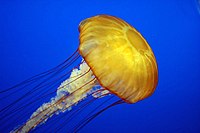
Photo from wikipedia
The purpose of the work was to determine the intraspecific variability of the stinging nettle, in respect of the mass of leaves and their chemical composition, including the content of… Click to show full abstract
The purpose of the work was to determine the intraspecific variability of the stinging nettle, in respect of the mass of leaves and their chemical composition, including the content of phenolic compounds and assimilative pigments. The objects of the study were 10 populations of nettle, originating from the eastern and southern part of Poland. The results obtained indicate a high level of variability between and within the populations investigated but not strictly related to their geographical locations. The mass of the leaves ranged from 0.19 to 0.28 kg dry weight (DW)/plant (Coefficient of variation (CV) = 16.33%). Using HPLC–DAD, four phenolic acids were detected, i.e., caffeoylmalic (570.97–1367.40 mg/100 g DW), chlorogenic (352.79–1070.83 mg/100 g DW), neochlorogenic (114.56–284.77 mg/100 g DW) and cichoric (58.31–189.52 mg/100 g DW) acids, with the last one differentiating populations to the highest degree (CV = 48.83%). All of the analyzed populations met the requirements of the European Pharmacopoeia (Ph Eur 10th) concerning the minimum content of caffeoylmalic and chlorogenic acids in nettle leaves (not less than 0.3%). Within the flavonoid fraction, two compounds were identified, namely rutoside (917.05–1937.43 mg/100 g DW, CV = 21.32%) and hyperoside (42.01–289.45 mg/100 g DW; CV = 55.26%). The level of chlorophyll a ranged from 3.82 to 4.49 mg/g DW, chlorophyll b from 1.59 to 2.19 mg/g DW, while the content of carotenoids varied from 2.34 to 2.60 mg/100 g DW. Given all the traits investigated, the level of a population’s polymorphism (CV) was visibly higher within a population than between populations. Population no. 4 was distinguished by the highest mass of leaves, and the highest content of rutoside, while population no. 2 was distinguished by the highest content of hyperoside, caffeoylmalic and chlorogenic acid.
Journal Title: Molecules
Year Published: 2023
Link to full text (if available)
Share on Social Media: Sign Up to like & get
recommendations!